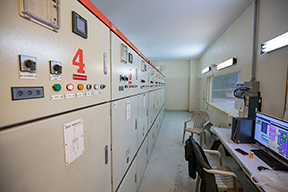PUC successfully restores power in Pohnpei after marathon session
- Details
- Category: News
- Published: Thursday, 23 April 2020 22:03
- Written by Bill Jaynes
- Hits: 4592
By Bill Jaynes
The Kaselehlie Press
March 4, 2020
 Pohnpei—Power outages earlier this week were caused by problems with cable connections inside Pohnpei Utilities Corporation’s power plant in Nanpohnmal. The cables carry the electronic information necessary for the generators to work together when they are put on line. The generators were not properly synchronizing, causing island wide power outages for customers beginning at 4:45 in the afternoon on March 2 and lasting anywhere from four to seven hours as PUC mechanics and engineers fought to solve the problem.
Pohnpei—Power outages earlier this week were caused by problems with cable connections inside Pohnpei Utilities Corporation’s power plant in Nanpohnmal. The cables carry the electronic information necessary for the generators to work together when they are put on line. The generators were not properly synchronizing, causing island wide power outages for customers beginning at 4:45 in the afternoon on March 2 and lasting anywhere from four to seven hours as PUC mechanics and engineers fought to solve the problem.
Though power was restored late that night, the problem had not been completely solved. On the next day, PUC announced a schedule of planned outages on a region by region basis. It only had to implement that “load shedding” plan once and even then for not as long as PUC had thought would be needed. PUC employees were able to complete necessary repairs during that one power outage that lasted from 10:00 until about 10:40 that morning. Since that time, power has been restored to Pohnpei.
PUC General Manager Nixon Anson said that power plant operators noticed a problem with synchronization several weeks ago. PUC notified Hawthorne Power Systems in San Diego whose technicians set up the system several years ago. “We have good working relationships with Hawthorne,” Anson said. The company sent a representative at its own cost. The technician arrived on February 11 to correct the problems with synchronization among the generators.
Three weeks later, the problems appeared again, this time with more detrimental results to the Pohnpei populace. Anson said that he charged his employees with checking each end of the many communications cables on each generator that connect to the switching system. Generators had to be shut down while employees painstakingly pulled each cable end and checked for proper connections. They found that some of the cables had loosened, possibly due to the vibration of the operating generators, an odd situation considering that Hawthorne representatives had been working to resolve the same problem.
the many communications cables on each generator that connect to the switching system. Generators had to be shut down while employees painstakingly pulled each cable end and checked for proper connections. They found that some of the cables had loosened, possibly due to the vibration of the operating generators, an odd situation considering that Hawthorne representatives had been working to resolve the same problem.
The Nanpohnmal power plant itself has a power generation capacity of 9.2 megawatts. During daylight hours and during rainy times, PUC can draw on approximately 2 megawatts of additional power from solar and hydro sources. Anson said that at peak demand, Pohnpei’s power customers draw down approximately 6 megawatts. Peak hours generally occur between 11:00 AM and 2:00 PM on weekdays. There is a much smaller peak beginning as the sun starts to go down as consumers get home. That small peak starts to dissipate beginning at about 10:00 at night as they wind down and head to bed.
The generators and the renewable power sources are more than enough to supply power during the high peak hours. Employees monitor a switching system to ensure that no one generator is overtasked. Even with employee monitoring, generators still need to talk to each other in order to synchronize. When they couldn’t on March 2, power generation capacity was reduced to below demand. In order for workers to perform diagnostics, generators had to be shut down while employees worked, resulting in the power outages on March 2 and 3.
PUC recommends that customers get the grounds in their homes checked. Anson said that all too often ground wires are not connected at every outlet or fixture in homes. He said that electricity will seek ground wherever it can be found. If the ground wires are properly connected, excess power will go through the home’s ground rod. If it can’t go there it will take the path of least resistance, possibly through an expensive appliance plugged into the wall.
Anson said that surge suppressors are also effective though he admits that he personally doesn’t use them. To protect against brown outs, low voltage situations, which are more damaging to expensive appliances than power surges especially if a surge suppressor is in place, an uninterruptable power supply (UPS) is effective to raise the voltage if it drops. He said that PUC has a 1.2 megawatt reserve unit at the power plant that raises output frequency and voltage to the proper levels if they drop below standard. If frequency and voltage are over standard, the excess charges the reserve unit. He said that power that PUC delivers is at standard but voltage drops can occur for a variety of reasons including trees on lines.






